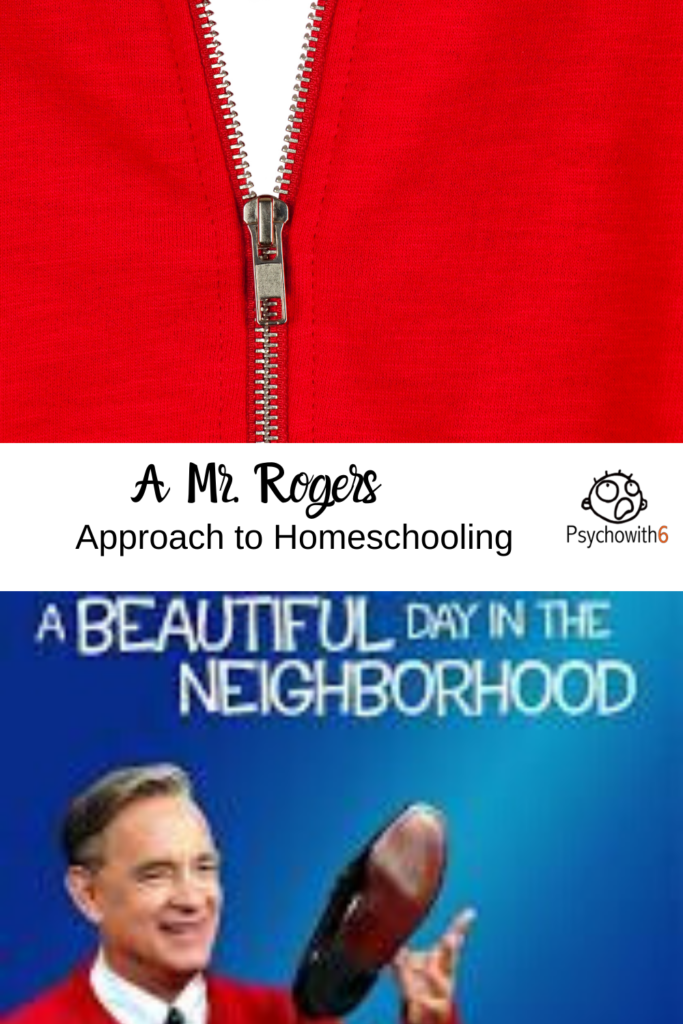
I watched the movie A Beautiful Day in the Neighborhood about Mr. Rogers and his relationship with a journalist who was sent to interview him. It is rated PG and is a drama that is not fast-paced. For that reason, I think young children would be bored. However, I highly recommend it for you as a homeschooler.
Mr. Rogers wasn’t a homeschooler and, as far as I know, had nothing to say about homeschooling. But I think his life and the way he lived it had a lot to say about it. I’m going to share with you six approaches to homeschooling that we can take from Mr. Rogers’s life. I believe these approaches could be transformative to your homeschooling and especially to your family.
Delight in your child.
The first approach we can take in homeschooling that is derived from Mr. Rogers’s life and work is to delight in your child.
In the opening scene of Mr. Rogers on set, we see him meeting with a child and his family. He is on his knee and commenting on a sword the child is holding. He does not ask the child a number of questions. Instead, he makes observations about the sword, allowing the child to correct him. This is standard procedure in play therapy. Making observations rather then asking questions makes children feel comfortable with us. Children have to answer multiple questions a day and grow weary of them. (I know. Moms do too, but hang with me here.) The final observation Mr. Rogers makes of the child and his sword is positive. He expresses wonder at the child’s strength. The child’s response is to hug Mr. Rogers.
How can we express delight in our own children? Let’s consider a child’s writing. Rather then asking what a child was trying to say in a piece of writing, we can make observations. It looks like you put a lot of thought into this. It seems like you really love this subject. If we are observing a child’s artwork, we might talk about the movement or emotion of the piece. We might comment on the beautiful colors.
Mr. Rogers also expressed delight in having the opportunity to get to know the journalist. In the same way, we can express our joy when our children wake up in the morning, or when they assemble for morning basket time, or when our teens come home from work. That leads me to Mr. Rogers’s principal number two.
Relationships come first.
While Mr. Rogers met with the child and his parents, the journalist asked his staff how often he did that. The staff sighed and and answered, “Every day.” They expressed their chagrin at the delays that these interactions caused their production crew.
When we have a needy toddler, teen, or spouse, we have a tendency to react the way Mr. Rogers’s production team did. We can become frustrated as we see these relationship issues as an interruption to our real work. Mr. Rogers would say that people are our real work. They should always come first, even if that means the math, the handwriting, or the history has to come later.
We can apply this principle by reminding ourselves every day that we are first and foremost about relationship building. As a homeschooling mom of six, I can say unequivocally that my relationships with my children are the greatest blessing of teaching them at home and not their superior education.
EQ is just as important as IQ.
The third Mr. Rogers principle that can apply to homeschooling is that EQ or emotional intelligence is just as important as IQ.
Mr. Rogers started his television program to address children’s emotional and social skills as opposed to the intellectual skills that were being addressed on Sesame Street. We see the importance of EQ in some gifted children who struggle. They can feel lonely, irritable, or depressed if they haven’t been taught emotional and social skills. We are not providing a whole education if we only focus on academics.
If we want to apply Mr. Rogers’s principle to our homeschooling, we have to take time to address sibling conflict. We have to teach our children how to manage grief. We have to teach our children how to make friends, how to handle teasing, how to handle disappointment, and so much more. We can use books and movies to teach these skills, and we can also use life experiences to prompt us. Again, we can do this, even if it means we get behind on our lesson plans.
Listen more and talk less.
The fourth Mr. Rogers’s principle that we can apply to our homeschooling is to listen more and talk less. James 1:19 says “Be quick to listen, slow to speak, and slow to become angry.” Mr. Rogers appeared to be the embodiment of this verse. In fact, at some points the movie creates significant discomfort because nothing is being said. Mr. Rogers waits for his journalist friend to speak, and when he does, the words are powerful. Silence can prompt true expression.
We can apply this principle in our homeschools by spending less time lecturing and even reading and more time listening to what our children have to say. If we make an observation or ask a question and our children don’t immediately respond or say ‘I don’t know,’ we can practice productive silence. We can wait for our kids to be ready to share. Our children will talk more as they come to trust that our relationship with them comes first. Using observations rather than questions is more likely to allow our children to talk. Rather then correcting or directing, we can model Mr. Rogers in thanking them for sharing, even if they share something we don’t like.
Spend time in the Word and prayer.
The next principle of Mr. Rogers’s life that we can apply to our homeschooling is praying. Mr. Rogers spent time in the Word and in prayer daily. He prayed for those in his life who obviously needed help and even those who didn’t.
We can apply this to our homeschooling by praying for each of our children. We can pray that they would grow in faith and that they would grow physically, emotionally, and socially. Of course, we can and should pray for ourselves as well. Near the end of the movie, Mr. Rogers asks a dying man to pray for him. We can and should ask others to pray for us as we do the incredibly important job of homeschooling our children.
Tell children they’re loved as they are.
The final principle I want to share from Mr. Rogers’s life that we can apply to homeschooling is showing our children that they’re loved as they are.
Mr. Rogers frequently told his viewers that they were wonderful just as they were. We may object to that when we’re dealing with a child who is sinful and disruptive. But the truth is that children who are struggling won’t have the will to change until they know they are loved just as they are.
We can apply this principle to our homeschooling by reminding our children that even if they never get better at math, reading, or keeping their rooms clean, we couldn’t possibly love them any more. They’re loved just as they are. This was Jesus’ message for us. While we were still sinners, Jesus came to set us free from the wages of that sin.
That message is for you too. You’re loved just as you are. Even if you never get more organized, never understand algebra, never have an Instagram-worthy homeschool day, you’re wonderful just as you are. Your family loves you so very much. God does, too.
Conclusion
Thank you so much for giving me the honor of listening to this podcast. I’m amazed by the sacrifice you make for your family week after week.
I watched another movie this week and there is a quote from it that applies here. The movie is Fighting with My Family. It’s a true story about a professional wrestling family. The sister is chosen to go pro over the brother. The sister tells her brother, “Just because you don’t have millions of people applauding doesn’t means that your work isn’t important.” Homeschool mom, your work is so important.









I loved watching Mr. Rogers growing up, and was so touched by this film. It was a film worthy of our family’s time. So much to talk about.
Your connections from the movie to our every day life are great opportunities to put into practice.
Thanks for commenting, Kathy. I’m glad to know you’re another fan of the film and what Fred Rogers had to teach us.